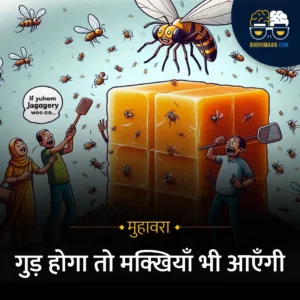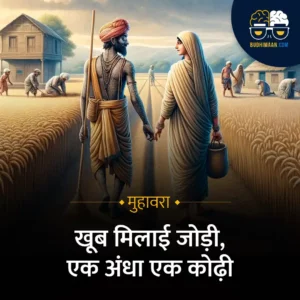परिचय: हिंदी भाषा अपनी अद्वितीयता में अनेक मुहावरों की खान है, जिन्हें समझने से विचारों की गहराई महसूस होती है। ‘हाथ को हाथ न सूझना’ ऐसा ही एक रोचक मुहावरा है।
अर्थ: ‘हाथ को हाथ न सूझना’ मुहावरे का अर्थ होता है कुछ दिखाई न देना। जब किसी चीज़ का पता न चले तब इसे प्रयोग में लाया जाता है।
उत्पत्ति: यह मुहावरा हाथ के अदृश्य हो जाने से संबंधित है। जैसे हाथ आमतौर पर हमारे नजर के सामने होते हैं, लेकिन जब अँधेरा हो जाये या धुंध हो जाएं तो उसेहाथ को हाथ न सूझना कहते हैं।
उदाहरण:
-> जब अंश अंधेरे कमरे में गया, तो उसे अपना हाथ भी नहीं सूझा।
-> जंगल में इतनी घानी धुंध थी कि अनुज को अपना हाथ भी नहीं सूझ रहा था।
विवेचना: ‘हाथ को हाथ न सूझना’ मुहावरा एक विशेष स्थिति को दर्शाता है जहाँ किसी वस्तु या व्यक्ति का अभिगम या पहचान पाना मुश्किल हो।
निष्कर्ष: ‘हाथ को हाथ न सूझना’ मुहावरा हमें यह दिखाता है कि किसी स्थिति में अदृश्यता की अवस्था की ओर इंगीत करता है, जिसे समझकर हमें उचित निर्णय और प्रतिक्रिया करनी चाहिए।

हाथ को हाथ न सूझना मुहावरा पर कहानी:
एक बार की बात है, एक गाँव में दो सहेलियां रहती थीं, अपर्णा और पूजा। वे दोनों बचपन से ही सखियों की तरह जीवन बिता रही थीं। एक दिन, उन्हें जंगल में लकड़ी काटने जाना पड़ा। जब वे वापस आ रही थीं, तो अचानक एक अधिक घनी धुंध छाने लगी।
धुंध इतनी घनी थी कि अपर्णा को अपना ही हाथ नहीं सूझ रहा था। वह भ्रांति में पड़ गई और पूजा से अलग हो गई। अपर्णा घबराई हुई आवाज में पूजा को पुकारने लगी, परंतु उसकी आवाज धुंध में डूबती जा रही थी।
पूजा ने समझा कि अपर्णा को उसका हाथ सूझ नहीं रहा होगा और वह अधिक घबराई हुई होगी। इसलिए, पूजा ने एक पुराने तरीके का सहारा लिया। वह जमीन पर अपनी चप्पल छोड़ दी और अपर्णा की ओर बढ़ती गई।
जब अपर्णा ने जमीन पर चप्पल महसूस की, तो उसे समझ में आया कि यह पूजा की चप्पल है और वह उसी दिशा में बढ़ती गई। धीरे-धीरे, दोनों फिर से एक-दूसरे के पास पहुँच गईं।
इस घटना ने दिखाया कि कभी-कभी हालात ऐसे होते हैं जब हमें अपनी समझ और अनुभव का सहारा लेना पड़ता है, चाहे हमें जो भी अदृश्य हो। अपर्णा और पूजा की कहानी से हमें यह सिखने को मिलता है कि हालात कितने भी कठिन हों, अगर हमारी सोच सही है तो हमें हर मुश्किल का समाधान मिल सकता है।
शायरी:
धुंध में भी जब हाथ सूझता नहीं,
ज़िंदगी के उस मोड़ पर खड़ा हूँ मैं।
दिल के जज्बातों की गहरी गलियों में,
खोजता वो जो आँखों से दिखता नहीं।
जब भी दुनिया की धुंध में खो जाऊँ,
तेरी यादों का सहारा लेता हूँ मैं।

आशा है कि आपको इस मुहावरे की समझ आ गई होगी और आप इसका सही प्रयोग कर पाएंगे।
Hindi to English Translation of हाथ को हाथ न सूझना – Hath ko hath na sujhna Idiom:
Introduction: The Hindi language is a treasure trove of unique idioms that, when understood, reveal profound insights. ‘Hath ko hath na sujhna’ is one such intriguing idiom.
Meaning: The idiom ‘Hath ko hath na sujhna’ translates to not being able to see something right in front of you. It is used when one cannot figure out or recognize something.
Origin: This idiom relates to the invisibility of the hand. Just as hands are typically in our sight, when it becomes dark or foggy, and we cannot see them, it is described as ‘Hath ko hath na sujhna’.
Usage:
-> When Ansh went into the dark room, he couldn’t even make out his own hand.
-> There was such dense fog in the forest that Anuj couldn’t see his own hand.
Discussion: The idiom ‘Hath ko hath na sujhna’ depicts a particular situation where it becomes challenging to access or identify an object or individual.
Conclusion: The idiom ‘Hath ko hath na sujhna’ illustrates a state of invisibility in certain situations, guiding us to make appropriate decisions and reactions based on understanding its essence.
Story of Bagula Bhagat Hona Idiom in English:
Once upon a time, in a village, there lived two friends, Aparna and Pooja. They had been living life like companions since childhood. One day, they had to venture into the forest to collect wood. As they were returning, suddenly, a dense fog enveloped the area.
The fog was so thick that Aparna couldn’t even see her own hand. She got disoriented and got separated from Pooja. In a panic, Aparna began calling out to Pooja, but her voice was getting lost in the fog.
Pooja realized that Aparna might be struggling to see even her own hand and would be more anxious. So, Pooja used an old trick. She left her slipper on the ground and started moving towards Aparna.
When Aparna felt the slipper under her foot, she understood that it was Pooja’s and started moving in that direction. Gradually, the two were reunited.
This incident showed that sometimes circumstances are such that we need to rely on our understanding and experience, no matter what remains invisible to us. From Aparna and Pooja’s story, we learn that no matter how challenging the situation, if our approach is right, we can find a solution to every problem.
I hope this gives you a clear understanding of the proverb and how to use it correctly
FAQs:
“हाथ को हाथ न सूझना” मुहावरे का विपरीत मुहावरा क्या होगा?
“हाथ को हाथ न सूझना” का विपरीत मुहावरा “सब कुछ साफ साफ दिखाई देना” हो सकता है, जिसका मतलब है सब कुछ स्पष्ट रूप से दिखाई देना।
“हाथ को हाथ न सूझना” मुहावरे का इतिहास क्या है?
इस मुहावरे का विशेष इतिहास तो नहीं मिलता, लेकिन यह पुराने समय से भारतीय समाज में प्रचलित है, जिसका उपयोग अत्यधिक अंधेरे या भ्रम की स्थितियों का वर्णन करने के लिए किया जाता रहा है।
क्या “हाथ को हाथ न सूझना” केवल शाब्दिक अर्थ में लागू होता है?
नहीं, यह मुहावरा शाब्दिक अर्थ में अत्यधिक अंधेरे को दर्शाने के साथ-साथ लाक्षणिक अर्थ में भ्रम या असमंजस की स्थिति को भी दर्शाता है।
“हाथ को हाथ न सूझना” मुहावरे का आधुनिक संदर्भ में क्या महत्व है?
आधुनिक संदर्भ में, यह मुहावरा जटिलताओं और चुनौतियों के समय में अनुभव होने वाले भ्रम और असमंजस को दर्शाता है, विशेष रूप से तकनीकी या जीवन के अन्य पहलुओं में।
“हाथ को हाथ न सूझना” मुहावरे का मनोवैज्ञानिक पहलू क्या है?
यह मुहावरा मनोवैज्ञानिक पहलुओं पर प्रकाश डालता है, जैसे कि अत्यधिक तनाव, चिंता, या अज्ञात के भय के कारण अनुभव होने वाला भ्रम और असमंजस।
हिंदी मुहावरों की पूरी लिस्ट एक साथ देखने के लिए यहाँ क्लिक करें
यह मुहावरा मानव शरीर के अंगों पर आधारित मुहावरे पेज पर भी उपलब्ध है।








